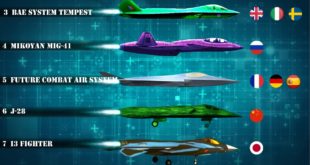The US Air Force is taking a crucial step to safeguard its technological edge by investing nearly half a billion dollars in anti-tamper technologies. This initiative, spearheaded by the Air Force Life Cycle Management Center, aims to equip military electronics with robust defenses against adversaries seeking to steal sensitive information …
Read More »Airborne Mobile Satellite Communications on the Move (COTM) technologies for Aircrafts and UAVs
The future of aviation is marked by significant growth in air travel, air cargo, and private general aviation. A key component of this growth is the increasing demand for reliable and high-speed satellite communication technologies, both for passenger services and for operational data transmission in aircraft and UAVs (Unmanned Aerial …
Read More »The Dawn of Sixth Generation Fighters: Dominating Future Air Superiority in Anti-Access/Area-Denial Environments
As global military dynamics evolve, the race to achieve air superiority has propelled technological innovation to new heights. The advent of sixth-generation fighters marks a significant leap in this journey, promising to redefine aerial combat and maintain dominance in increasingly complex anti-access/area-denial (A2/AD) environments. These advanced aircraft, currently under development …
Read More »Advancing Air Dominance: US Air Force Seeks Cutting-Edge Tech
Introduction: The US Air Force is on a mission to secure air dominance like never before. With adversaries constantly evolving their tactics and technologies, the need for innovative solutions has never been greater. That’s why the US Air Force Research Laboratory (AFRL) has issued a call for the brightest minds …
Read More »Pushing the Limits: The Importance of Aerospace Propulsion Systems Testing
In the dynamic world of aerospace engineering, where innovation is the norm and pushing the boundaries of technology is a daily pursuit, one critical aspect stands out – propulsion systems testing. These tests form the backbone of aerospace development, ensuring safety, reliability, and performance in the skies and beyond. The …
Read More »Unlocking the Future of Aviation: Exploring the Advanced Superconducting and Cryogenic Experimental PowertraiN Demonstrator (ASCEND)
In the realm of aviation, the quest for innovation and efficiency is unceasing. Aircraft manufacturers, engineers, and researchers are constantly pushing the boundaries of technology to create more sustainable, efficient, and powerful aircraft propulsion systems. One such groundbreaking endeavor is the Advanced Superconducting and Cryogenic Experimental PowertraiN Demonstrator, or ASCEND. …
Read More »Unveiling the Krasukha Electronic Warfare system: Russia’s Shield Against Airborne and Satellite Threats
Introduction: In an era marked by escalating tensions and evolving warfare techniques, the role of electronic warfare (EW) systems has become increasingly critical. Among these cutting-edge systems stands the Krasukha Electronic Warfare System, a formidable defense against both airborne and satellite threats. Developed by Concern Radio-Electronic Technologies (KRET), a subsidiary …
Read More »Advancing Dominance: U.S. Air Force Doctrine on Electromagnetic Spectrum Operations
Introduction: In the ever-evolving landscape of modern warfare, the U.S. Air Force stands poised at the forefront, armed not only with cutting-edge technology but also with strategic doctrine designed to seize and maintain dominance across all domains. With the release of its latest doctrine on Electromagnetic Spectrum (EMS) Operations on …
Read More »Advancing Aviation: The Rise of More Electric Aircraft (MEA) and All Electric Aircraft technologies
In recent years, the aviation industry has been undergoing a significant transformation driven by technological advancements and a growing emphasis on sustainability. One of the most promising developments in this regard is the emergence of More Electric Aircraft (MEA) and All Electric Aircraft (AEA). These innovative aircraft designs leverage new …
Read More »DARPA CRANE: Elevating Stealth with X-Planes and Active Flow Control
Introduction: In the ever-evolving landscape of aerospace technology, advancements in stealth capabilities remain a top priority for military agencies worldwide. DARPA, the Defense Advanced Research Projects Agency, has been at the forefront of fostering innovation in this domain. One of their latest endeavors, the Control of Revolutionary Aircraft with Novel …
Read More » International Defense Security & Technology Your trusted Source for News, Research and Analysis
International Defense Security & Technology Your trusted Source for News, Research and Analysis


